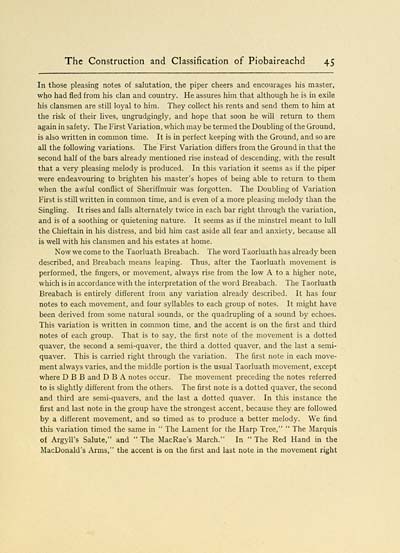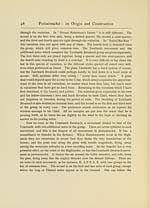Download files
Complete book:
Individual page:
Thumbnail gallery: Grid view | List view

The Construction and Classification of Piobaireachd 45
In those pleasing notes of salutation, the piper cheers and encourages his master,
who had fled from his clan and country. He assures him that although he is in exile
his clansmen are still loyal to him. They collect his rents and send them to him at
the risk of their lives, ungrudgingly, and hope that soon he will return to them
again in safety. The First Variation, which may be termed the Doubling of the Ground,
is also written in common time. It is in perfect keeping with the Ground, and so are
all the following variations. The First Variation differs from the Ground in that the
second half of the bars already mentioned rise instead of descending, with the result
that a very pleasing melody is produced. In this variation it seems as if the piper
were endeavouring to brighten his master's hopes of being able to return to them
when the awful conflict of Sheriffmuir was forgotten. The Doubling of Variation
First is still written in common time, and is even of a more pleasing melody than the
Singling. It rises and falls alternately twice in each bar right through the variation,
and is of a soothing or quietening nature. It seems as if the minstrel meant to lull
the Chieftain in his distress, and bid him cast aside all fear and an.xiety, because all
is well with his clansmen and his estates at home.
Now we come to the Taorluath Breabach. The word Taorluath has already been
described, and Breabach means leaping. Thus, after the Taorluath movement is
performed, the fingers, or movement, always rise from the low A to a higher note,
which is in accordance with the interpretation of the word Breabach. The Taorluath
Breabach is entirely different from any variation already described. It has four
notes to each movement, and four syllables to each group of notes. It might have
been derived from some natural sounds, or the quadrupling of a sound by echoes.
This variation is written in common time, and the accent is on the first and third
notes of each group. That is to say, the first note of the movement is a dotted
quaver, the second a semi-quaver, the third a dotted quaver, and the last a semi-
quaver. This is carried right through the variation. The first note in each move-
ment always varies, and the middle portion is the usual Taorluath movement, except
where D B B and DBA notes occur. The movement preceding the notes referred
to is slightly different from the others. The first note is a dotted quaver, the second
and third are semi-quavers, and the last a dotted quaver. In this instance the
first and last note in the group have the strongest accent, because they are followed
by a different movement, and so timed as to produce a better melody. We find
this variation timed the same in " The Lament for the Harp Tree," " The Marquis
of Argyll's Salute," and " The MacRae's March." In " The Red Hand in the
MacDonald's Arms," the accent is on the first and last note in the movement right
In those pleasing notes of salutation, the piper cheers and encourages his master,
who had fled from his clan and country. He assures him that although he is in exile
his clansmen are still loyal to him. They collect his rents and send them to him at
the risk of their lives, ungrudgingly, and hope that soon he will return to them
again in safety. The First Variation, which may be termed the Doubling of the Ground,
is also written in common time. It is in perfect keeping with the Ground, and so are
all the following variations. The First Variation differs from the Ground in that the
second half of the bars already mentioned rise instead of descending, with the result
that a very pleasing melody is produced. In this variation it seems as if the piper
were endeavouring to brighten his master's hopes of being able to return to them
when the awful conflict of Sheriffmuir was forgotten. The Doubling of Variation
First is still written in common time, and is even of a more pleasing melody than the
Singling. It rises and falls alternately twice in each bar right through the variation,
and is of a soothing or quietening nature. It seems as if the minstrel meant to lull
the Chieftain in his distress, and bid him cast aside all fear and an.xiety, because all
is well with his clansmen and his estates at home.
Now we come to the Taorluath Breabach. The word Taorluath has already been
described, and Breabach means leaping. Thus, after the Taorluath movement is
performed, the fingers, or movement, always rise from the low A to a higher note,
which is in accordance with the interpretation of the word Breabach. The Taorluath
Breabach is entirely different from any variation already described. It has four
notes to each movement, and four syllables to each group of notes. It might have
been derived from some natural sounds, or the quadrupling of a sound by echoes.
This variation is written in common time, and the accent is on the first and third
notes of each group. That is to say, the first note of the movement is a dotted
quaver, the second a semi-quaver, the third a dotted quaver, and the last a semi-
quaver. This is carried right through the variation. The first note in each move-
ment always varies, and the middle portion is the usual Taorluath movement, except
where D B B and DBA notes occur. The movement preceding the notes referred
to is slightly different from the others. The first note is a dotted quaver, the second
and third are semi-quavers, and the last a dotted quaver. In this instance the
first and last note in the group have the strongest accent, because they are followed
by a different movement, and so timed as to produce a better melody. We find
this variation timed the same in " The Lament for the Harp Tree," " The Marquis
of Argyll's Salute," and " The MacRae's March." In " The Red Hand in the
MacDonald's Arms," the accent is on the first and last note in the movement right
Set display mode to: Large image | Transcription
Images and transcriptions on this page, including medium image downloads, may be used under the Creative Commons Attribution 4.0 International Licence unless otherwise stated. ![]()
| Early Gaelic Book Collections > Hew Morrison Collection > Piobaireachd > (51) |
|---|
| Permanent URL | https://digital.nls.uk/81164529 |
|---|
| Description | A selection of items from a collection of 320 volumes and 30 pamphlets of literary and religious works in Scottish Gaelic. From the personal library of Hew Morrison, the first City Librarian of Edinburgh. |
|---|
| Description | Selected items from five 'Special and Named Printed Collections'. Includes books in Gaelic and other Celtic languages, works about the Gaels, their languages, literature, culture and history. |
|---|

